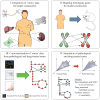Using the reconstructed genome-scale human metabolic network to study physiology and pathology
- PMID: 22142339
- PMCID: PMC3243107
- DOI: 10.1111/j.1365-2796.2011.02494.x
Using the reconstructed genome-scale human metabolic network to study physiology and pathology
Abstract
Metabolism plays a key role in many major human diseases. Generation of high-throughput omics data has ushered in a new era of systems biology. Genome-scale metabolic network reconstructions provide a platform to interpret omics data in a biochemically meaningful manner. The release of the global human metabolic network, Recon 1, in 2007 has enabled new systems biology approaches to study human physiology, pathology and pharmacology. There are currently more than 20 publications that utilize Recon 1, including studies of cancer, diabetes, host-pathogen interactions, heritable metabolic disorders and off-target drug binding effects. In this mini-review, we focus on the reconstruction of the global human metabolic network and four classes of its application. We show that computational simulations for numerous pathologies have yielded clinically relevant results, many corroborated by existing or newly generated experimental data.
© 2011 The Association for the Publication of the Journal of Internal Medicine.
Conflict of interest statement
The authors declare that they have no conflict of interest.
Figures


Similar articles
-
Systems medicine and metabolic modelling.J Intern Med. 2012 Feb;271(2):142-54. doi: 10.1111/j.1365-2796.2011.02493.x. J Intern Med. 2012. PMID: 22142312 Review.
-
A multi-tissue type genome-scale metabolic network for analysis of whole-body systems physiology.BMC Syst Biol. 2011 Oct 31;5:180. doi: 10.1186/1752-0509-5-180. BMC Syst Biol. 2011. PMID: 22041191 Free PMC article.
-
A detailed genome-wide reconstruction of mouse metabolism based on human Recon 1.BMC Syst Biol. 2010 Oct 19;4:140. doi: 10.1186/1752-0509-4-140. BMC Syst Biol. 2010. PMID: 20959003 Free PMC article.
-
Global reconstruction of the human metabolic network based on genomic and bibliomic data.Proc Natl Acad Sci U S A. 2007 Feb 6;104(6):1777-82. doi: 10.1073/pnas.0610772104. Epub 2007 Jan 31. Proc Natl Acad Sci U S A. 2007. PMID: 17267599 Free PMC article.
-
Understanding human metabolic physiology: a genome-to-systems approach.Trends Biotechnol. 2009 Jan;27(1):37-44. doi: 10.1016/j.tibtech.2008.09.007. Epub 2008 Nov 17. Trends Biotechnol. 2009. PMID: 19010556 Review.
Cited by
-
GIM3E: condition-specific models of cellular metabolism developed from metabolomics and expression data.Bioinformatics. 2013 Nov 15;29(22):2900-8. doi: 10.1093/bioinformatics/btt493. Epub 2013 Aug 23. Bioinformatics. 2013. PMID: 23975765 Free PMC article.
-
iMM1865: A New Reconstruction of Mouse Genome-Scale Metabolic Model.Sci Rep. 2020 Apr 10;10(1):6177. doi: 10.1038/s41598-020-63235-w. Sci Rep. 2020. PMID: 32277147 Free PMC article.
-
The Proteome of a Healthy Human during Physical Activity under Extreme Conditions.Acta Naturae. 2014 Jul;6(3):66-75. Acta Naturae. 2014. PMID: 25349715 Free PMC article.
-
The structure of a gene co-expression network reveals biological functions underlying eQTLs.PLoS One. 2013;8(4):e60045. doi: 10.1371/journal.pone.0060045. Epub 2013 Apr 5. PLoS One. 2013. PMID: 23577081 Free PMC article.
-
Using networks to measure similarity between genes: association index selection.Nat Methods. 2013 Dec;10(12):1169-76. doi: 10.1038/nmeth.2728. Nat Methods. 2013. PMID: 24296474 Free PMC article.
References
-
- Palsson B, Zengler K. The challenges of integrating multi-omic data sets. Nat Chem Biol. 2010(6):11–787. - PubMed
-
- Becker SA, Feist AM, Mo ML, Hannum G, Palsson BO, Herrgard MJ. Quantitative prediction of cellular metabolism with constraint-based models: The COBRA Toolbox. Nat Protocols. 2007;2(3):727–738. - PubMed
Publication types
MeSH terms
Grants and funding
LinkOut - more resources
Full Text Sources
Other Literature Sources

